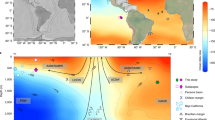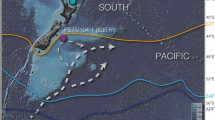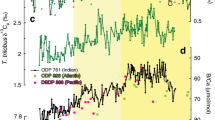Abstract
At the end of the Last Glacial Maximum (19,000 to 11,000 years ago), atmospheric carbon dioxide concentrations rose while the Δ14C of atmospheric carbon dioxide declined1,2. These changes have been attributed to an injection of carbon dioxide with low radiocarbon activity from an oceanic abyssal reservoir that was isolated from the atmosphere for several thousand years before deglaciation3. The current understanding points to the Southern Ocean as the main area of exchange between these reservoirs4. Intermediate water formed in the Southern Ocean surrounding Antarctica would have then carried the old carbon dioxide signature to the lower-latitude oceans5,6. Here we reconstruct the Δ14C signature of Antarctic Intermediate Water off the coast of Chile for the past 20,000 years, using paired 14C ages of benthic and planktonic foraminifera. In contrast to the above scenario, we find that the Δ14C signature of the Antarctic Intermediate Water closely matches the modelled surface ocean Δ14C, precluding the influence of an old carbon source. We suggest that if the abyssal ocean is indeed the source of the radiocarbon-depleted carbon dioxide, an alternative path for the mixing and propagation of its carbon dioxide may be required to explain the observed changes in atmospheric carbon dioxide concentration and radiocarbon activity.
This is a preview of subscription content, access via your institution
Access options
Subscribe to this journal
Receive 12 print issues and online access
$259.00 per year
only $21.58 per issue
Buy this article
- Purchase on Springer Link
- Instant access to full article PDF
Prices may be subject to local taxes which are calculated during checkout



Similar content being viewed by others
References
Monnin, E. et al. Atmospheric CO2 concentrations over the last glacial termination. Science 291, 112–114 (2001).
Hughen, K., Southon, J., Lehman, S., Bertrand, C. & Turnbull, J. Marine-derived 14C calibration and activity record for the past 50,000 years updated from the Cariaco Basin. Quat. Sci. Rev. 25, 3216–3227 (2006).
Broecker, W. & Barker, S. A 190‰ drop in atmosphere’s Δ14C during the ‘Mystery Interval’ (17.5–14.5 kyr). Earth Planet. Sci. Lett. 256, 90–99 (2007).
Fischer, H. et al. The role of Southern Ocean processes in orbital and millennial CO2 variations— A synthesis. Quat. Sci. Rev. 10.1016/j.quascirev.2009.06.007 (2009).
Marchitto, T., Lehman, S., Ortiz, J., Fluckiger, J. & van Geen, A. Marine radiocarbon evidence for the mechanism of deglacial atmospheric CO2 rise. Science 316, 1456–1459 (2007).
Spero, H. & Lea, D. The cause of carbon isotope minimum events on glacial terminations. Science 296, 522–525 (2002).
Fairbanks, R. et al. Radiocarbon calibration curve spanning 0–50,000 years BP based on paired Th-230/U-234/U-238 and C-14 dates on pristine corals. Quat. Sci. Rev. 24, 1781–1796 (2005).
Beck, J. et al. Extremely large variations of atmospheric 14C concentration during the last glacial period. Science 292, 2453–2458 (2001).
Stephens, B. & Keeling, R. The influence of Antarctic sea ice on glacial–interglacial CO2 variations. Nature 404, 171–174 (2000).
Francois, R. et al. Contribution of Southern Ocean surface-water stratification to low atmospheric CO2 concentrations during the last glacial period. Nature 389, 929–935 (1997).
Adkins, J., McIntyre, K. & Schrag, D. The salinity, temperature, and δ18O of the glacial deep ocean. Science 298, 1769–1773 (2002).
Sikes, E. L., Samson, C. R., Guilderson, T. P. & Howard, W. R. Old radiocarbon ages in the southwest Pacific Ocean during the last glacial period and deglaciation. Nature 405, 555–559 (2000).
Stott, L., Southon, J., Timmermann, A. & Koutavas, A. Radiocarbon age anomaly at intermediate water depth in the Pacific Ocean during the last deglaciation. Paleoceanography 24, PA2223 (2009).
Anderson, R. et al. Wind-driven upwelling in the southern ocean and the deglacial rise in atmospheric CO2 . Science 323, 1443–1448 (2009).
Toggweiler, J. Shifting westerlies. Science 323, 1434–1435 (2009).
Sloyan, B. & Rintoul, S. Circulation, renewal, and modification of Antarctic mode and intermediate water. J. Phys. Oceanogr. 31, 1005–1030 (2001).
Iudicone, D., Rodgers, K., Schopp, R. & Madec, G. An exchange window for the injection of Antarctic Intermediate Water into the South Pacific. J. Phys. Oceanogr. 37, 31–49 (2007).
Schneider, W. & Bravo, L. Argo profiling floats document Subantarctic Mode Water formation west of Drake Passage. Geophys. Res. Lett. 33, L16609 (2006).
Butzin, M., Prange, M. & Lohmann, G. Radiocarbon simulations for the glacial ocean: The effects of wind stress, Southern Ocean sea ice and Heinrich events. Earth Planet. Sci. Lett. 235, 45–61 (2005).
Key, R. et al. A global ocean carbon climatology: Results from Global Data Analysis Project (GLODAP). Glob. Biogeochem. Cycles 18, GB4031 (2004).
Pahnke, K., Goldstein, S. & Hemming, S. Abrupt changes in Antarctic Intermediate water circulation over the past 25,000 years. Nature Geosci. 1, 870–874 (2008).
Toggweiler, J., Russell, J. & Carson, S. Midlatitude westerlies, atmospheric CO2, and climate change during the ice ages. Paleoceanography 21, PA2005 (2006).
Knorr, G. & Lohmann, G. Southern Ocean origin for the resumption of Atlantic thermohaline circulation during deglaciation. Nature 424, 532–536 (2003).
Pahnke, K. & Zahn, R. Southern Hemisphere water mass conversion linked with North Atlantic climate variability. Science 307, 1741–1746 (2005).
Bostock, H., Opdyke, B., Gagan, M. & Fifield, L. Carbon isotope evidence for changes in Antarctic Intermediate Water circulation and ocean ventilation in the southwest Pacific during the last deglaciation. Paleoceanography 19, PA4013 (2004).
Broecker, W. The mysterious C-14 decline. Radiocarbon 51, 109–119 (2009).
Mohtadi, M. et al. Deglacial pattern of circulation and marine productivity in the upwelling region off central-south Chile. Earth Planet. Sci. Lett. 272, 221–230 (2008).
Acknowledgements
We thank M. Carman and the National Ocean Science Accelerator Mass Spectrometer Facility and Keck Carbon Cycle Accelerator Mass Spectrometer staff for technical support. Financial support for this work came from the NSF grant OCE-0751643. R.D.P.-H. was supported by the Cooperative Institute for Climate and Ocean Research (CICOR) postdoctoral fellowship at the Woods Hole Oceanographic Institution.
Author information
Authors and Affiliations
Contributions
R.D.P.-H. and L.K. conceived the study. R.D.P.-H. collected the foraminifera and wrote the paper with the help of all the co-authors. J.S. supplied ideas that shaped the final version. D.H. and M.M. collected the core material and provided the samples. Core SO161-SL22 was retrieved for M.M. doctoral thesis work. All authors contributed to the writing of this manuscript.
Corresponding author
Ethics declarations
Competing interests
The authors declare no competing financial interests.
Supplementary information
Supplementary Information
Supplementary Information (PDF 432 kb)
Rights and permissions
About this article
Cite this article
De Pol-Holz, R., Keigwin, L., Southon, J. et al. No signature of abyssal carbon in intermediate waters off Chile during deglaciation. Nature Geosci 3, 192–195 (2010). https://doi.org/10.1038/ngeo745
Received:
Accepted:
Published:
Issue Date:
DOI: https://doi.org/10.1038/ngeo745
This article is cited by
-
Variable ventilation ages in the equatorial Indian Ocean thermocline during the LGM
Scientific Reports (2023)
-
Persistently well-ventilated intermediate-depth ocean through the last deglaciation
Nature Geoscience (2020)
-
Increased Ventilation of the Northern Indian Ocean during the Last Deglaciation
Journal of the Geological Society of India (2020)
-
An atmospheric chronology for the glacial-deglacial Eastern Equatorial Pacific
Nature Communications (2018)
-
Synchronous deglacial thermocline and deep-water ventilation in the eastern equatorial Pacific
Nature Communications (2017)



